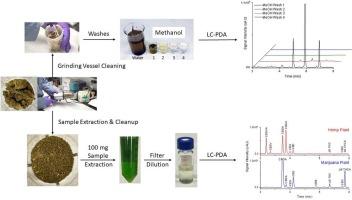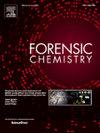High-throughput LC-PDA method for determination of Δ9-THC and related cannabinoids in Cannabis sativa
IF 2.2
3区 医学
Q2 CHEMISTRY, ANALYTICAL
引用次数: 0
Abstract
Before the passage of the Agriculture Improvement Act of 2018, more commonly referred to as the 2018 Farm Bill, forensic laboratories were only required to perform qualitative measurements to confirm the identity of seized plant samples as Cannabis sativa (hemp or marijuana). The new law defines hemp at a federal level as Cannabis sativa containing 0.3 % or less Δ9-THC. Because forensic laboratories were not adequately equipped with the proper methods or training to meet these requirements, significant backlogs in casework resulted. The National Institute of Standards and Technology (NIST) responded by providing analytical tools to the forensic community. An accurate and precise method was previously developed to determine Δ9-THC, Δ9-THCA, and total Δ9-THC in botanical samples based on liquid chromatography with photodiode array detection (LC-PDA). Cannabis plant samples were ground and extracted with methanol using routine laboratory equipment. The original sample preparation procedure was time-consuming, taking over 70 min. The method described here has been optimized with the time required for sample preparation and LC-PDA analysis has been reduced to less than 30 min.

测定大麻中 Δ9-THC 和相关大麻素的高通量 LC-PDA 方法
在《2018 年农业改进法案》(通常称为《2018 年农业法案》)通过之前,法医实验室只需进行定性测量,以确认查获的植物样本是否为大麻(Cannabis sativa)。新法律在联邦层面将大麻定义为含有 0.3% 或更少 Δ9-THC 的大麻。由于法医实验室没有充分配备适当的方法或培训来满足这些要求,导致案件工作严重积压。美国国家标准与技术研究院(NIST)通过向法医界提供分析工具做出了回应。此前已开发出一种准确而精确的方法,基于液相色谱法和光电二极管阵列检测法 (LC-PDA),测定植物样本中的Δ9-THC、Δ9-THCA 和总Δ9-THC。使用常规实验室设备将大麻植物样本研磨并用甲醇提取。最初的样品制备过程耗时超过 70 分钟。本文介绍的方法经过优化,将样品制备和 LC-PDA 分析所需的时间缩短至 30 分钟以内。
本文章由计算机程序翻译,如有差异,请以英文原文为准。
求助全文
约1分钟内获得全文
求助全文
来源期刊

Forensic Chemistry
CHEMISTRY, ANALYTICAL-
CiteScore
5.70
自引率
14.80%
发文量
65
审稿时长
46 days
期刊介绍:
Forensic Chemistry publishes high quality manuscripts focusing on the theory, research and application of any chemical science to forensic analysis. The scope of the journal includes fundamental advancements that result in a better understanding of the evidentiary significance derived from the physical and chemical analysis of materials. The scope of Forensic Chemistry will also include the application and or development of any molecular and atomic spectrochemical technique, electrochemical techniques, sensors, surface characterization techniques, mass spectrometry, nuclear magnetic resonance, chemometrics and statistics, and separation sciences (e.g. chromatography) that provide insight into the forensic analysis of materials. Evidential topics of interest to the journal include, but are not limited to, fingerprint analysis, drug analysis, ignitable liquid residue analysis, explosives detection and analysis, the characterization and comparison of trace evidence (glass, fibers, paints and polymers, tapes, soils and other materials), ink and paper analysis, gunshot residue analysis, synthetic pathways for drugs, toxicology and the analysis and chemistry associated with the components of fingermarks. The journal is particularly interested in receiving manuscripts that report advances in the forensic interpretation of chemical evidence. Technology Readiness Level: When submitting an article to Forensic Chemistry, all authors will be asked to self-assign a Technology Readiness Level (TRL) to their article. The purpose of the TRL system is to help readers understand the level of maturity of an idea or method, to help track the evolution of readiness of a given technique or method, and to help filter published articles by the expected ease of implementation in an operation setting within a crime lab.
 求助内容:
求助内容: 应助结果提醒方式:
应助结果提醒方式:


